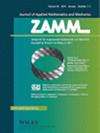多孔波壁腔中反应混合纳米流体的磁流体力学自然对流
IF 3.2
4区 工程技术
Q1 MATHEMATICS, APPLIED
Zamm-zeitschrift Fur Angewandte Mathematik Und Mechanik
Pub Date : 2023-08-31
DOI:10.1002/zamm.202200476
引用次数: 0
摘要
在倾斜磁场作用下,研究了一种化学反应的杂化纳米流体在嵌入多孔介质中的封闭波壁腔中的自然对流。假设空腔的左壁是波浪形的,并且保持在周围的温度。将控制方程转化为无因次方程,用有限差分法求解。为了验证求解过程,进行了网格灵敏度测试并与已发表的结果进行了比较。讨论了不同瑞利数(Ra)、哈特曼数(Ha)、Frank - Kamenetskii数(Fk)、达西数(Da)、联合浮力参数(N)和纳米颗粒体积分数(φ1和φ2)的浓度流线、等温线和等温线。流线显示顺时针和逆时针旋涡,与参数无关。当Fk = 0.5时,最大流函数(ψmax)为0.64,最大温度(θmax)为0.20,而当Fk = 2时,ψmax和θmax分别为4.08和1.36。此外,当Ha = 0时,ψmax和θmax分别为1.61和0.379,而当Ha = 100时,ψmax为0.90和θmax为0.377。最高温度随Ra、N、Fk的增加而升高,随Ha、Da的增加而降低。浓度等值线表现出与温度相反的特征。Ra、Da和Fk的增加增强了流线的强度,而Ha、N和体积分数的增加则相反。此外,涡旋的眼在磁场方向上是扭曲的。本文章由计算机程序翻译,如有差异,请以英文原文为准。
Magnetohydrodynamic natural convection of a reacting hybrid nanofluid in a porous wavy‐walled cavity
Natural convection of a chemically reacting hybrid nanofluid in a closed wavy‐walled cavity embedded in a porous medium is investigated with an inclined magnetic field. The left wall of the cavity is assumed to be wavy and the walls are maintained at the surrounding temperature. Governing equations are transformed into dimensionless equations which are solved using the finite difference method. To validate the solving procedure, a grid sensitivity test and a comparison with published results have been carried out. Streamlines, isotherms, and isolines of concentration are discussed for varying Rayleigh number (Ra), Hartmann number (Ha), Frank‐Kamenetskii number (Fk), Darcy number (Da), combined buoyancy parameter (N), and nanoparticle volume fractions (φ1 and φ2). Streamlines show clockwise and anticlockwise vortices irrespective of the parameters. For Fk = 0.5, the maximum stream function (ψmax) is 0.64 and the maximum temperature (θmax) is 0.20 while for Fk = 2, ψmax and θmax are 4.08 and 1.36, respectively. Besides, for Ha = 0, ψmax and θmax are 1.61 and 0.379, however, for Ha = 100, ψmax is 0.90 and θmax is 0.377. Maximum temperature is increased with an increase in Ra, N, and Fk, whereas it is decreased with the augmentation of Ha and Da. Isolines of concentration show reverse characteristics of temperature. An increase in Ra, Da, and Fk enhances the intensity of streamlines but the opposite is observed for higher Ha, N and volume fractions. Moreover, the eyes of the vortices are distorted in the direction of the magnetic field.
求助全文
通过发布文献求助,成功后即可免费获取论文全文。
去求助
来源期刊
CiteScore
3.30
自引率
8.70%
发文量
199
审稿时长
3.0 months
期刊介绍:
ZAMM is one of the oldest journals in the field of applied mathematics and mechanics and is read by scientists all over the world. The aim and scope of ZAMM is the publication of new results and review articles and information on applied mathematics (mainly numerical mathematics and various applications of analysis, in particular numerical aspects of differential and integral equations), on the entire field of theoretical and applied mechanics (solid mechanics, fluid mechanics, thermodynamics). ZAMM is also open to essential contributions on mathematics in industrial applications.

 求助内容:
求助内容: 应助结果提醒方式:
应助结果提醒方式:


